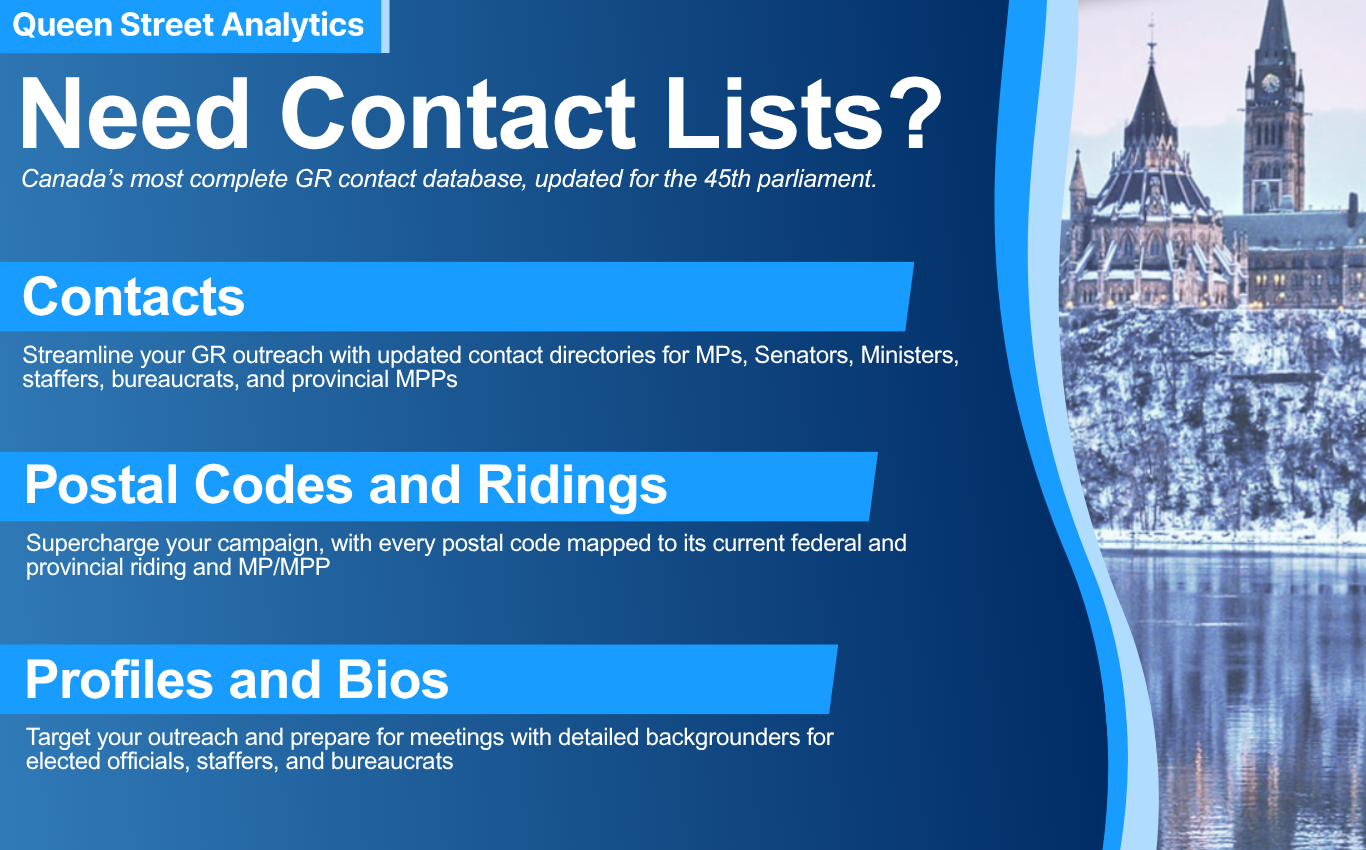QSA's Week in Automotive (#46, 2025)
Canada finalizes interprovincial trade rules for auto sector; Ottawa boosts hydrogen truck R&D; Competition Bureau signals ongoing reforms; U.S. moves on vehicle safety, compliance, and trade measures.

Good morning! This is Queen Street Analytics' weekly roundup of regulatory developments, legislative discussions, political announcements and other government-related news for car manufacturers, parts suppliers, car dealers, and others in the automotive industry. Every Monday, we break down the most important updates in this space in under five minutes.
Want to track the upstream and downstream forces affecting Automotive? Don’t miss this week’s updates in Manufacturing and Oil & Gas.
Dates: 2025-11-16 to 2025-11-22
📋 In This Week's Newsletter
• 🏛️ This Week's Parliamentary Calendar
• 🇨🇦 Canadian Federal Government News
• 🗺️ Canadian Provincial Government News
• 🇺🇸 US Federal Government News
• 📚 What We're Reading This Week
This Week's Parliamentary Calendar
- House committee to examine Electric Vehicle Availability Standard implementation: The Environment and Sustainable Development Committee will meet on November 24 to review the Electric Vehicle Availability Standard, featuring witnesses from The Atmospheric Fund, Electro-Federation Canada, Équiterre, Global Automakers of Canada, Propulsion Québec, and the Association des véhicules électriques du Québec.
- Government Operations committee reviews Stellantis contracts in response to parliamentary motion: On November 25, the Government Operations and Estimates Committee will discuss government responses on contracts with FCA Canada Inc. and Innovation, Science and Economic Development Canada, with key witnesses attending via videoconference.
- International Trade committee prepares for CUSMA review: The International Trade Committee will meet November 24 to discuss Canada’s position for the forthcoming CUSMA (NAFTA) review, including participation from the Canada Organic Trade Association, Canadian Animal Health Institute, Canadian Institute of Steel Construction, and Canadian Labour Congress.
- Natural Resources committee reviews supplementary estimates and federal energy programs: The Natural Resources Committee meets on November 24 for supplementary estimates review, with Minister Tim Hodgson and senior officials from the Department of Natural Resources scheduled to appear.
- Senate committee considers logistics network resilience during labor disruptions: On November 19, the Standing Senate Committee on Transport and Communications, chaired by Senator Larry Smith, held discussions on maintaining fuel supply chains during strikes, with input from the Canadian Fuels Association, Canadian Propane Association, and Canada Industrial Relations Board.
Canadian Federal Government News
Canada finalizes regulations for Free Trade and Labour Mobility Act, impacting auto manufacturers and component suppliers
On November 17, the federal government published regulations for the Free Trade and Labour Mobility in Canada Act ahead of its January 2026 implementation. The new framework allows automotive manufacturers and component suppliers to meet federal regulatory requirements if products or services meet comparable provincial standards, reducing duplication and facilitating interprovincial vehicle and parts movement. Exceptions remain for food safety requirements under the Safe Food for Canadians Act and for agricultural supply-managed products. A user guide for businesses will be released in December 2025, with detailed guidance for occupations such as locomotive engineers. Industry feedback shaped the rules, focusing on balancing efficiency with ongoing public safety, including proof of good standing and additional assessments for certain regulated roles. These changes position Canada as one of the first jurisdictions to formally harmonize federal regulations with provincial and territorial counterparts for physical goods and services, including those relevant to the motor vehicle sector.
Sources: www.canada.ca

Federal funding backs hydrogen engine innovation for heavy-duty vehicles
Natural Resources Canada announced on November 21 over $1.4 million in funding for Hydra Energy Canada Corporation to support a research project optimizing hydrogen co-combustion engines in heavy-duty trucks. The project focuses on increasing hydrogen's role in engine combustion alongside diesel to achieve lower tailpipe emissions and improved fuel efficiency. Machine learning models will be developed to further enhance performance and emission reductions. Commercial vehicle trials are scheduled in British Columbia using retrofitted trucks, representing an early deployment of hydrogen engine retrofits in the Canadian auto sector. Officials stated this initiative is expected to help reduce operational costs and position Canada competitively in the clean transportation technology market.
Sources: www.canada.ca
Prairies Economic Development Canada invests in medical vehicle manufacturing expansion in Manitoba
On November 21, Prairies Economic Development Canada announced a $2.9 million investment supporting two Manitoba enterprises, including $1.1 million for MoveMobility, a specialized vehicle manufacturer expanding into ambulance production. Funds will allow increased production capacity for accessible and medical transport vans, extending options for vehicle fleets serving healthcare and community needs. This regional investment, announced in Rosser, aims to bolster supply chain capabilities for specialty auto manufacturers and address medical transportation gaps in remote regions.
Sources: www.canada.ca
Competition Bureau outlines enforcement and legislative priorities impacting automotive industry
Speaking at the Canadian Bar Association Competition Fall Law Conference on November 20, Commissioner Matthew Boswell reviewed recent legislative amendments to the Competition Act and new enforcement guidelines. The Bureau is expediting market studies in critical sectors and accelerating casework on merger reviews, monopolistic practices, and deceptive marketing. Highlights for the auto sector include ongoing revisions to merger enforcement guidelines, a focus on competitive financing for SMEs, and increased vigilance around procurement in major infrastructure initiatives such as transit systems. The Bureau is actively integrating advanced digital enforcement tools—including AI-driven detection for competition harms—into its investigative processes. Firms engaged in the Canadian vehicle supply chain may experience procedural changes under these reforms, especially for large-scale mergers or supply contracts involving competitive bidding.
Sources: www.canada.ca
Competition Bureau Canada details international cooperation and digital enforcement activities
Commissioner Matthew Boswell addressed international legal professionals at the International Bar Association Annual Conference on November 4, noting that three rounds of Competition Act amendments have aligned Canada's approach with advanced digital market enforcement. Boswell described cooperation agreements with international bodies and the establishment of Canada's Digital Enforcement and Intelligence Branch, which now includes technologists and data engineers tracking automotive and related industry competitiveness. These activities are set to further harmonize Canadian enforcement with approaches in the EU, UK, and multilateral organizations, affecting cross-border M&A activities and regulatory expectations in the automotive market.
Sources: www.canada.ca
New motor vehicle sales rise in September, but dealer revenues fall
According to Statistics Canada, September 2025 saw 168,731 new motor vehicles sold across Canada, a 1.2% increase over September 2024. Despite the unit growth, sales revenue declined by 3.2% year-over-year. Truck sales increased by 2.9% while passenger car sales dropped 10.1%, reflecting ongoing consumer preferences and inventory dynamics in auto retail.
Sources: www.statcan.gc.ca
Retail trade slows, motor vehicle and parts sales lead declines
Statistics Canada reported that total retail trade fell by 0.7% to $69.8 billion in September 2025. Motor vehicle and parts dealers were among the subsectors showing sharp declines, coinciding with reduced consumer spending and shifting vehicle segment demand.
Sources: www.statcan.gc.ca
Data on capital expenditures for environmental protection available for Canadian automotive and related industries
Statistics Canada has released data on capital expenditures for environmental protection by Canadian industries for 2022 and 2023, including manufacturers and auto sector participants not covered in previous surveys. The information, now available, allows automotive firms to benchmark costs associated with environmental regulatory compliance and process improvements.
Sources: www.statcan.gc.ca
Updated petroleum product production and inventory statistics released
New October 2025 data on Canadian refined petroleum product production and inventories is now available on request from Statistics Canada. Auto manufacturers, distributors, and rental or fleet operators can use these updates to inform supply chain and operational planning for conventional and alternative fuel vehicles.
Sources: www.statcan.gc.ca
Customs Mutual Assistance Agreement with Ukraine ratification underway
Canada Border Services Agency announced that the ratification process for a Customs Mutual Assistance Agreement (CMAA) with Ukraine has begun. The agreement, signed August 2025, will enhance customs data sharing to prevent fraud and support secure international vehicle and component trade between Canada and Ukraine, complementing similar agreements with major trade partners.
Sources: www.canada.ca
Federal ministers convene Committee on Internal Trade, advance agreements for goods, trucking, and financial services
On November 19, federal and provincial officials met at the Committee on Internal Trade in Yellowknife, confirming deals that remove interprovincial trade barriers for goods, trucking services, and financial industry providers. For the automotive sector, Nova Scotia and other provinces agreed that most goods lawfully sold in one jurisdiction can move across Canadian borders without additional requirements, except for specific exclusions such as food and used beekeeping equipment. Details of new trucking standards harmonize steering axle weight and oversized vehicle requirements, aligning safety and operational practices nationally.
Sources: news.novascotia.ca
Canadian Provincial Government News
B.C. revises EV sales mandate and introduces ZEV Affordability Program for automakers
The province of British Columbia will update its zero-emission vehicle framework, recalibrate targets in spring 2026, and provide automakers more flexibility through expanded ZEV credits and range requirement relaxations for plug-in hybrids.
Sources: news.gov.bc.ca
Ontario introduces Buy Ontario Act, prioritizing provincial automotive goods in public procurement
Ontario presented legislation to prioritize Ontario-made vehicles, parts, and services in public sector contracts, with compliance requirements and penalties for vendors and agencies.
Sources: news.ontario.ca
Ontario secures $3.2 billion investment in synthetic graphite for EV batteries in St. Thomas
Vianode will build a large-scale synthetic graphite facility to supply EV battery production, supported by a provincial loan of up to $670 million, enabling up to 150,000 tons of annual capacity.
Sources: news.ontario.ca
Ontario supports tariff-impacted manufacturers with $16.5 million in funding through Ontario Together Trade Fund
Eight Ontario companies, including auto part manufacturers, will receive support to boost production, re-shore supply chains, and safeguard jobs threatened by U.S. tariffs, as part of a larger $30 billion support plan.
Sources: news.ontario.ca
Alberta announces new license plate design featuring Moraine Lake and security features
Alberta will launch a new reflective license plate design in 2026, chosen via public vote, introducing improved visibility, legibility, and counterfeit resistance for law enforcement and automated systems.
Sources: www.alberta.ca
US Federal Government News
National Highway Traffic Safety Administration renews data collection for vehicle defect and noncompliance reporting
NHTSA, under the Motor Vehicle Safety Act, will continue requiring manufacturers to notify the agency and affected parties of safety-related defects and failures to comply with FMVSS. Regulations at 49 CFR parts 573 and 577 remain in effect, and the associated paperwork burden for manufacturers is estimated at 68,879 hours annually, factoring in VIN lookup tool compliance and recall notification mandates. Annual costs, including labor and notification expenses, total approximately $85.6 million.
Sources: www.federalregister.gov
International Trade Commission seeks public interest input on proposed exclusion orders for vehicle safety and telematics systems
On November 20, the USITC issued a second notice in Section 337 Investigation No. 337-TA-1393, soliciting public submissions on limited exclusion orders and cease-and-desist orders for certain vehicle telematics, fleet management, and video-based safety systems imported by Motive Technologies Inc. Comments on the possible impact of such remedies on public health, U.S. consumers, and competitive conditions are due November 25, 2025.
Sources: www.federalregister.gov
FMCSA proposes to update Hazardous Materials Safety Permits regulations for vehicle inspections
The Federal Motor Carrier Safety Administration published a Notice of Proposed Rulemaking to incorporate the April 1, 2025, edition of the Commercial Vehicle Safety Alliance handbook into its out-of-service criteria for inspections involving transuranic waste and highway route-controlled radioactive materials. Fourteen HMSP-related updates are proposed, introducing clarification in OOS violation criteria without imposing new requirements. Public comments on the changes are invited until December 19, 2025.
Sources: www.federalregister.gov
FMCSA renews exemption for amber pulsating brake lamps on commercial vehicles
Grote Industries, LLC received FMCSA approval to continue the use of amber, brake-activated auxiliary pulsating lamps on commercial motor vehicles, alongside standard red brake lamps, from December 3, 2025, through December 2, 2030. The exemption requires specific lamp activation protocols and annual reporting, and may be rescinded if safety conditions change.
Sources: www.federalregister.gov
NHTSA publishes request for comments on vehicle and child restraint compliance reporting burden
NHTSA seeks public feedback by January 20, 2026, on a proposed new information collection impacting automotive and child restraint manufacturers. The annual compliance reporting is estimated at 1,456 hours and $77,482.28 in labor costs, supporting OVSC compliance testing and certification programs for vehicle safety standards.
Sources: www.federalregister.gov
What We're Reading This Week
- As auto companies retreat from Canada, do government subsidies still make sense?: Analysis of evolving government support for the Canadian auto sector amid shifting industry trends.
- Ottawa urged to pause its EV sales mandate until auto sector emerges from turmoil: Calls for reconsideration of national EV sales targets in the context of ongoing industry challenges.
- Fast cars and easy money: Insurance agents penalized for role in luxury car 'grey market': Report on disciplinary action involving BC auto insurance agents linked to luxury car transactions.
- Global News at 5:30 and 6:30: Quebec's Auditor General investigates provincial funding for EV battery manufacturing.
- B.C. plans to lower EV sales mandate to achievable levels, minister says: Provincially driven policy adjustments aiming for realistic ZEV adoption targets.
- GAC Accelerates European EV Strategy with Magna Vehicle Assembly Program: Coverage of global automaker expansion through Canadian partnerships for EV production.
- Ontario lands $3.2 billion EV-related factory amid trade tensions with U.S.: New EV supply chain investment in Ontario under ongoing trade strains.
- Why Chinese EVs keep haunting Liberal prime ministers: Examination of political and market challenges related to Chinese-origin EV imports.
- Ontario Protecting Families by Holding Impaired Drivers Accountable: Ontario considers child support reforms for impaired drivers implicated in fatalities.
- Carbon Market: Québec and California Hold 45th Joint Auction of Greenhouse Gas Emission Units Today: Québec and California hold another cap-and-trade auction for emission units.


